The strontium optical lattice clock market is forecasted to attain USD 11.3 million in 2025 and increase to USD 31.5 million by 2035, offering an absolute dollar opportunity of USD 20.2 million over the forecast period. In the first phase, from 2021 to 2025, the market grows from USD 6.8 million to USD 11.3 million, with intermediate values of USD 7.5 million, 8.3 million, and 9.2 million. Growth during this period is driven by increasing applications in high-precision timekeeping, scientific research, and space exploration, where the unique capabilities of strontium-based optical lattice clocks provide unparalleled accuracy and stability.
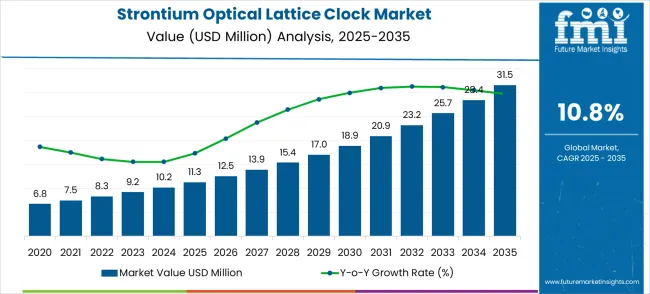
Between 2026 and 2030, the market is expected to expand further, increasing from USD 11.3 million to USD 17.0 million, with values passing through USD 12.5 million, USD 13.9 million, and USD 15.4 million. This phase is characterized by stronger growth, driven by increased demand for precision measurement in telecommunications, navigation systems, and quantum technology.
By 2035, the market is anticipated to reach USD 31.5 million, with the absolute dollar opportunity reflecting a steady rise through intermediate values of USD 18.9 million, USD 20.9 million, USD 23.2 million, USD 25.7 million, and USD 28.4 million. Continued technological advancements and the broadening scope of strontium optical lattice clock applications contribute to this significant dollar growth opportunity.
| Strontium Optical Lattice Clock Market | Value |
|---|---|
| Market Value (2025) | USD 11.3 million |
| Market Forecast Value (2035) | USD 31.5 million |
| Market Forecast CAGR | 10.8% |
The quantum computing market plays a pivotal role, contributing approximately 25-30% to the overall market share. Strontium optical lattice clocks are integral in quantum experiments and quantum networks, where their accuracy and stability are crucial. The time and frequency standards market is the largest driver, accounting for 30-35%, as these clocks provide highly precise timekeeping and frequency measurements essential for global navigation, telecommunications, and scientific research. In the telecommunications market, which contributes about 10-12%, strontium optical lattice clocks help synchronize communication systems, ensuring reliable data transmission and supporting high-performance fiber-optic networks and GPS systems.
The scientific research market, including fields like physics and astronomy, accounts for 15-18%, where these clocks are used for experiments and precise data collection. The aerospace and defense market, with a share of 5-8%, relies on strontium optical lattice clocks for satellite navigation, communications, and ensuring accuracy in defense-related applications.
The market is entering a transformative phase of growth, driven by demand for ultra-precise timing, the expansion of quantum technology, and evolving requirements for telecommunications infrastructure. By 2035, these pathways together can unlock USD 12-15 million in incremental revenue opportunities beyond baseline growth.
Pathway A -- Laboratory Research Leadership (Lab-Grade Systems) The lab-grade segment already holds the largest share due to its ultimate precision capabilities. Expanding system capabilities, automation features, and measurement protocols can consolidate leadership. Opportunity pool: USD 3.5-4.5 million.
Pathway B -- Telecommunications Infrastructure Growth Telecommunications & data centers account for the majority of commercial demand. Growing network complexity, especially in 5G and quantum communications, will drive higher adoption of ultra-precise frequency standards. Opportunity pool: USD 2.5-3.5 million.
Pathway C -- Space Applications & Navigation Systems Space science & exploration applications present significant growth potential due to next-generation satellite constellations and deep space missions requiring unprecedented timing precision. Opportunity pool: USD 2.0-2.5 million.
Pathway D -- Emerging Market Expansion Asia-Pacific, particularly China and India, presents a growing demand due to rising quantum technology investments. Targeting research institutions and telecommunications infrastructure will accelerate adoption. Opportunity pool: USD 1.5-2.0 million.
Pathway E -- Portable & Fieldable Systems Development. Development of transportable systems for field deployment opens new application areas in geodesy, fundamental physics tests, and distributed timing networks. Opportunity pool: USD 1.0-1.5 million.
Pathway F -- Quantum Communication Networks Integration with quantum communication systems and quantum internet infrastructure offers premium positioning for next-generation secure communications. Opportunity pool: USD 0.8-1.2 million.
Pathway G -- Service, Maintenance & Technical Support. Recurring revenue from system maintenance, laser servicing, and technical support contracts creates a sustainable long-term revenue stream. Opportunity pool: USD 0.5-0.8 million.
Pathway H -- Standards & Metrology Applications Integration with national timing standards and international frequency comparison networks strengthens the fundamental role of optical lattice clocks in global metrology. Opportunity pool: USD 0.2-0.5 million
Why is the Strontium Optical Lattice Clock Market Growing?
Market expansion is being supported by the rapid advancement of quantum technologies worldwide and the corresponding need for ultra-precise timekeeping systems that provide superior frequency stability and unprecedented accuracy levels. Modern telecommunications networks, navigation systems, and scientific research facilities rely on consistent timing precision to ensure optimal performance, including 5G networks, satellite constellations, and fundamental physics experiments. Even minor timing inaccuracies can require comprehensive system recalibrations to maintain optimal operational standards and measurement precision.
The growing complexity of quantum sensing requirements and increasing demand for high-precision frequency standards are driving demand for strontium optical lattice clock systems from certified manufacturers with appropriate quantum expertise and technical capabilities. Telecommunications companies and research institutions are increasingly requiring documented frequency stability and system reliability to maintain service quality and measurement accuracy. Industry specifications and performance standards are establishing standardized timing procedures that require specialized quantum technologies and trained operators.
The emergence of quantum communication networks and advanced space-based applications is creating unprecedented demand for portable and space-qualified optical lattice clocks. These applications require frequency standards that can maintain their precision in challenging environments while providing the ultra-high stability needed for quantum protocols and relativistic measurements.
The market is segmented by clock type, application, and region. By clock type, the market is divided into lab-grade, transportable/fieldable, space-qualified, and others. Based on application, the market is categorized into telecommunications & data centers, global navigation & positioning, space science & exploration, and others. Regionally, the market is divided into North America, Europe, East Asia, South Asia & Pacific, Latin America, and Middle East & Africa.
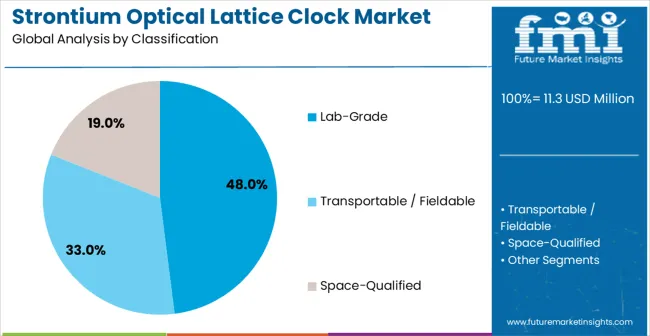
The lab-grade strontium optical lattice clock segment is projected to capture 48% of the total market share in 2025, reaffirming its position as the leading category. This dominance is driven by the precision and frequency stability these systems provide, making them the go-to choice for fundamental research and primary frequency standards. Lab-grade clocks are preferred for their ability to achieve fractional frequency uncertainties below 10^-18, ideal for quantum sensing applications and experiments in fundamental physics. They meet the stringent timing requirements of national metrology institutes, universities, and research labs, offering unmatched accuracy and long-term stability. The combination of cutting-edge technology, reliable performance, and robust support systems from top manufacturers continues to solidify the dominance of this segment in the market.
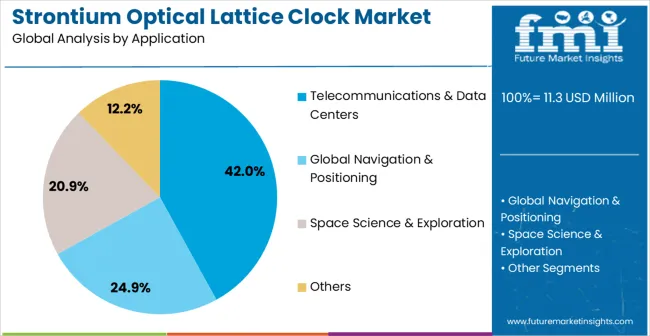
The telecommunications & data centers segment is expected to represent 42% of the strontium optical lattice clock demand in 2025, making it the leading commercial application sector. This is due to the critical need for ultra-precise frequency synchronization in modern telecommunications infrastructure. Strontium optical lattice clocks are essential for high-performance networks, including 5G, quantum communication systems, and data-heavy transmissions. Their ability to deliver exceptional frequency stability over extended periods makes them perfect for demanding operational environments. The rise of global telecommunications infrastructure, along with a focus on performance differentiation, continues to drive demand. Additionally, the growth of data centers, cloud computing, and network optimization investments further bolsters the need for reliable frequency references, ensuring the telecommunications & data center sector remains the largest market driver.
The strontium optical lattice clock market is witnessing rapid advancements due to the growing demand for ultra-precise timekeeping and atomic clocks in scientific research, telecommunications, and defense applications. Demand is driven by the need for improved time synchronization, accurate frequency standards, and advancements in quantum technology. Challenges include high production costs, complex operational requirements, and the need for specialized materials and environments for precision operation. Opportunities lie in the growing adoption of optical lattice clocks in quantum computing, GPS systems, and atomic-based sensors. Trends include miniaturization, improved accuracy, and cross-sector applications, positioning strontium optical lattice clocks as a key enabler of next-generation scientific and technological innovations.
The strontium optical lattice clock market is growing due to the increasing demand for ultra-precise timekeeping in scientific research, telecommunications, and space exploration. These clocks offer unmatched precision, providing time standards essential for applications like GPS, communication network synchronization, and quantum computing advancements. With the ability to measure time with femtosecond accuracy, strontium-based optical lattice clocks are revolutionizing metrology. Their exceptional performance makes them indispensable for next-generation technologies that require highly accurate time measurements, including global positioning systems, advanced quantum systems, and space-based time synchronization. The demand for such precise time solutions is expected to rise as the need for precision in modern technological infrastructure continues to grow.
The market is trending toward miniaturization of strontium optical lattice clocks, making them more versatile and deployable in a wider range of applications, including portable and space-based systems. Improved accuracy is also a focal point, with ongoing research aimed at reducing error margins and extending the operational life of these clocks.
Furthermore, there is a growing interest in cross-sector applications, such as defense, navigation, and scientific experiments, where the precision of optical lattice clocks can provide critical benefits. Advancements in technology and cross-disciplinary collaborations are accelerating the integration of these clocks into various industries, positioning them as key components in next-generation technological innovations.
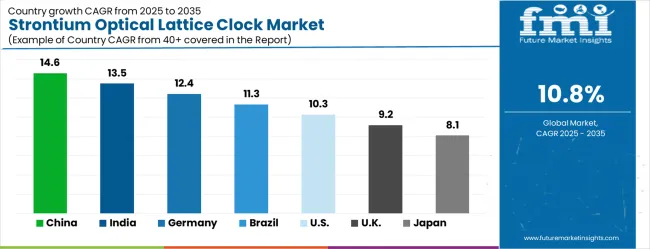
| Country | CAGR (2025-2035) |
|---|---|
| China | 14.6% |
| India | 13.5% |
| Germany | 12.4% |
| Brazil | 11.3% |
| United States | 10.3% |
| United Kingdom | 9.2% |
| Japan | 8.1% |
The strontium optical lattice clock market is growing rapidly, with China leading at a 14.6% CAGR through 2035, driven by massive investments in quantum technologies and national quantum network development. India follows at 13.5%, supported by expanding research infrastructure and growing emphasis on precision timing applications. Germany grows strongly at 12.4%, integrating optical lattice technology into its established quantum research ecosystem. Brazil records 11.3%, emphasizing scientific infrastructure modernization and quantum technology initiatives. The United States shows solid growth at 10.3%, focusing on advanced research applications and commercial telecommunications deployment. The United Kingdom demonstrates steady progress at 9.2%, maintaining established quantum technology research programs. Japan records 8.1% growth, concentrating on technological refinement and industrial applications.
The report covers an in-depth analysis of 40+ countries, with top-performing countries highlighted below.
China is projected to lead the strontium optical lattice clock market, with a CAGR of 14.6% from 2025 to 2035. The country’s investment in quantum technologies and space research initiatives is driving the adoption of high-precision timekeeping systems. The development of China’s space infrastructure, including its ambitious satellite programs, is a key factor contributing to the growth in demand for optical lattice clocks. The Chinese government’s focus on supporting cutting-edge scientific research and quantum computing technologies is fostering a favorable environment for the growth of advanced timekeeping systems. Optical lattice clocks are increasingly used in scientific experiments, telecommunications, and satellite-based applications requiring precise synchronization.
India is experiencing a rapid increase in demand for strontium optical lattice clocks, with an expected CAGR of 13.5% from 2025 to 2035. The country’s expansion in quantum research and space technology is driving the adoption of these precise timekeeping systems. India’s growing space exploration efforts, including the Chandrayaan missions, require accurate atomic clocks for satellite-based navigation and communication. The increasing need for precision timing in telecommunications, GPS systems, and scientific research is further contributing to the growth of the Strontium optical lattice clock market. The Indian government’s focus on bolstering scientific and technological advancements, particularly in quantum computing and space research, will likely drive future market expansion.
The strontium optical lattice clock market in Germany is set to grow at a CAGR of 12.4% from 2025 to 2035. As a global leader in quantum research and scientific innovation, Germany is increasingly relying on advanced timekeeping systems for precision measurements in space research and telecommunications. The country’s space agency, DLR, along with private sector projects, is investing in high-precision clocks to enhance satellite systems and communication networks. Germany is also playing a pivotal role in the European Space Agency’s (ESA) satellite programs, which require optical lattice clocks for accurate time synchronization. The robust industrial sector, which focuses on manufacturing and precision engineering, further contributes to the demand for Strontium optical lattice clocks, especially for advanced technological applications.
Brazil is projected to grow at a CAGR of 11.3% in the Strontium optical lattice clock market from 2025 to 2035. Brazil’s participation in space exploration projects and increasing collaborations with international space agencies, such as NASA and ESA, is significantly contributing to the demand for advanced timekeeping systems. As the country continues to expand its space missions and satellite navigation systems, the need for optical lattice clocks to ensure accurate synchronization across various technologies is expected to rise. The demand for Strontium optical lattice clocks is also driven by Brazil’s growing telecommunications and scientific research industries. Government initiatives to improve the country’s technological infrastructure are providing further opportunities for the market’s growth.
The United States is expected to grow at a CAGR of 10.3% in the Strontium optical lattice clock market from 2025 to 2035. As a leader in quantum research and space technologies, the USA has extensive applications for optical lattice clocks in national defense, satellite navigation systems, and telecommunications. The country’s National Aeronautics and Space Administration (NASA) and military applications rely heavily on accurate timekeeping systems for satellite synchronization, GPS, and space exploration. As the USA continues to innovate in quantum computing and communication systems, Strontium optical lattice clocks will play a crucial role in the advancement of these technologies. The increased need for precision in scientific experiments and industrial applications is further boosting the market.
The United Kingdom is expected to witness steady growth in the Strontium optical lattice clock market, with a CAGR of 9.2% from 2025 to 2035. The UK has been at the forefront of quantum research and is focusing on utilizing advanced timekeeping systems in space research, satellite communication, and precision measurement applications. The country’s active involvement in the European Space Agency (ESA) and international space projects has increased the demand for optical lattice clocks in satellite systems and space missions. The UK’s focus on developing high-precision measurement technologies to support both scientific and industrial sectors further drives market expansion.
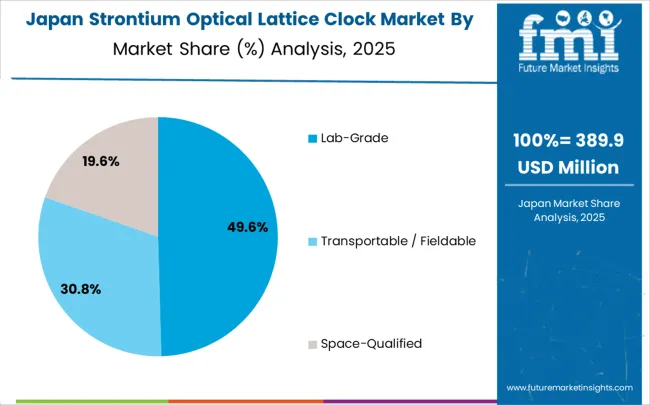
The strontium optical lattice clock market is expected to grow at a CAGR of 8.1% from 2025 to 2035. Japan’s space agency, JAXA, continues to push the boundaries of space exploration, increasing demand for high-precision timekeeping systems. Optical lattice clocks are essential for satellite synchronization, inter-satellite communication, and deep-space missions, which are significant parts of Japan’s expanding space programs. The need for accurate timekeeping in national telecommunications systems is further driving market growth. Japan’s focus on technological innovation, particularly in quantum and space sciences, is expected to contribute to the increasing adoption of Strontium optical lattice clocks.
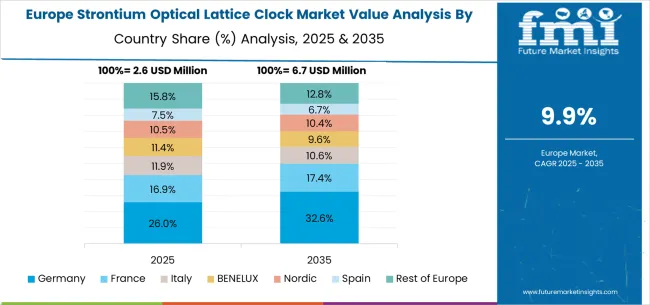
The strontium optical lattice clock market in Europe is forecast to expand from USD 3.2 million in 2025 to USD 8.9 million by 2035, registering a CAGR of 10.7%. Germany will remain the largest market, holding 35.0% share in 2025, rising to 36.2% by 2035, supported by strong quantum research infrastructure and precision measurement leadership. The United Kingdom follows, maintaining 28.0% in 2025 to 27.5% by 2035, driven by established national laboratories and international metrology standards. France is expected to hold steady at around 15.5%, reflecting consistent investment in quantum technology research. Italy maintains stability at approximately 8.5%, supported by university research programs and precision instrumentation development, while Spain grows from 6.0% to 6.5% with expanding scientific infrastructure and quantum initiative investments. Switzerland and Austria combined account for 4.5% to 4.8%, benefiting from precision technology expertise, while the remainder of Europe, including Nordic countries and Eastern European research centers, hovers near 2.0%--2.5%, balancing emerging quantum research programs against established Western European dominance.
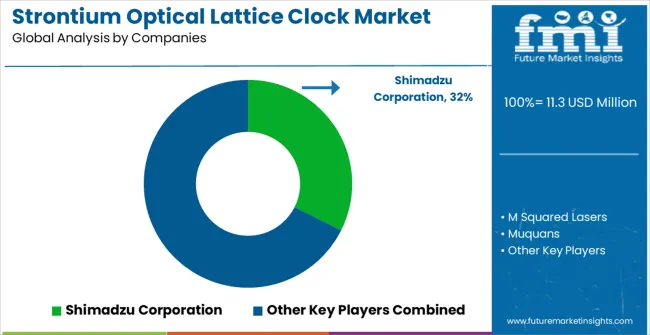
The market is defined by competition among specialized quantum technology manufacturers, precision instrumentation companies, and advanced research solution providers. Companies are investing in laser system development, quantum state manipulation optimization, vacuum system improvements, and comprehensive technical support capabilities to deliver reliable, precise, and cutting-edge frequency standard solutions. Strategic partnerships, technological innovation, and research collaboration are central to strengthening product portfolios and market presence.
Shimadzu Corporation offers comprehensive optical lattice clock solutions with established quantum technology expertise and precision instrumentation capabilities. M Squared Lasers provides specialized laser systems with a focus on frequency stability and optical performance. Muquans delivers advanced quantum sensing solutions with emphasis on portability and user-friendly operation. Menlo Systems specializes in precision laser technology with advanced frequency comb integration.
These companies continue to invest in research and development to advance optical lattice clock technology, improve system performance, and expand application possibilities. The competitive landscape is characterized by technological innovation, precision engineering, and the ability to provide comprehensive technical support for complex quantum systems.
| Item | Value |
|---|---|
| Quantitative Units | USD 11.3 million |
| Clock Type | Lab-Grade, Transportable/Fieldable, Space-Qualified |
| Application | Telecommunications & Data Centers, Global Navigation & Positioning, Space Science & Exploration, Others |
| Regions Covered | North America, Europe, East Asia, South Asia & Pacific, Latin America, Middle East & Africa |
| Country Covered | China, India, Germany, Brazil, United States, United Kingdom, Japan, and 40+ countries |
| Key Companies Profiled | Shimadzu Corporation, M Squared Lasers, Muquans, Menlo Systems |
| Additional Attributes | Dollar sales by clock type and application segment, regional demand trends across major markets, competitive landscape with established quantum technology manufacturers and emerging precision timing providers, customer preferences for different system configurations and performance specifications, integration with telecommunications infrastructure and scientific research protocols, innovations in laser stabilization and atomic manipulation technologies, and adoption of portable system designs with enhanced measurement capabilities for improved operational workflows. |
The global strontium optical lattice clock market is estimated to be valued at USD 11.3 million in 2025.
The market size for the strontium optical lattice clock market is projected to reach USD 31.5 million by 2035.
The strontium optical lattice clock market is expected to grow at a 10.8% CAGR between 2025 and 2035.
The key product types in strontium optical lattice clock market are lab-grade, transportable / fieldable and space-qualified.
In terms of application, telecommunications & data centers segment to command 42.0% share in the strontium optical lattice clock market in 2025.






Our Research Products

The "Full Research Suite" delivers actionable market intel, deep dives on markets or technologies, so clients act faster, cut risk, and unlock growth.

The Leaderboard benchmarks and ranks top vendors, classifying them as Established Leaders, Leading Challengers, or Disruptors & Challengers.

Locates where complements amplify value and substitutes erode it, forecasting net impact by horizon

We deliver granular, decision-grade intel: market sizing, 5-year forecasts, pricing, adoption, usage, revenue, and operational KPIs—plus competitor tracking, regulation, and value chains—across 60 countries broadly.

Spot the shifts before they hit your P&L. We track inflection points, adoption curves, pricing moves, and ecosystem plays to show where demand is heading, why it is changing, and what to do next across high-growth markets and disruptive tech

Real-time reads of user behavior. We track shifting priorities, perceptions of today’s and next-gen services, and provider experience, then pace how fast tech moves from trial to adoption, blending buyer, consumer, and channel inputs with social signals (#WhySwitch, #UX).

Partner with our analyst team to build a custom report designed around your business priorities. From analysing market trends to assessing competitors or crafting bespoke datasets, we tailor insights to your needs.
Supplier Intelligence
Discovery & Profiling
Capacity & Footprint
Performance & Risk
Compliance & Governance
Commercial Readiness
Who Supplies Whom
Scorecards & Shortlists
Playbooks & Docs
Category Intelligence
Definition & Scope
Demand & Use Cases
Cost Drivers
Market Structure
Supply Chain Map
Trade & Policy
Operating Norms
Deliverables
Buyer Intelligence
Account Basics
Spend & Scope
Procurement Model
Vendor Requirements
Terms & Policies
Entry Strategy
Pain Points & Triggers
Outputs
Pricing Analysis
Benchmarks
Trends
Should-Cost
Indexation
Landed Cost
Commercial Terms
Deliverables
Brand Analysis
Positioning & Value Prop
Share & Presence
Customer Evidence
Go-to-Market
Digital & Reputation
Compliance & Trust
KPIs & Gaps
Outputs
Full Research Suite comprises of:
Market outlook & trends analysis
Interviews & case studies
Strategic recommendations
Vendor profiles & capabilities analysis
5-year forecasts
8 regions and 60+ country-level data splits
Market segment data splits
12 months of continuous data updates
DELIVERED AS:
PDF EXCEL ONLINE
Optical Lattice Clock Market Size and Share Forecast Outlook 2025 to 2035
Optical Fiber Cold Joint Market Size and Share Forecast Outlook 2025 to 2035
Optical Spectrum Analyzer Market Size and Share Forecast Outlook 2025 to 2035
Optical Extinction Analyzer Market Size and Share Forecast Outlook 2025 to 2035
Optical Character Recognition Market Forecast and Outlook 2025 to 2035
Optical Satellite Market Size and Share Forecast Outlook 2025 to 2035
Optical Imaging Market Size and Share Forecast Outlook 2025 to 2035
Optical Whitening Agents Market Size and Share Forecast Outlook 2025 to 2035
Optical Fingerprint Collector Market Size and Share Forecast Outlook 2025 to 2035
Optical Lens Materials Market Size and Share Forecast Outlook 2025 to 2035
Optical Microscope Market Size and Share Forecast Outlook 2025 to 2035
Optical Component Tester Market Size and Share Forecast Outlook 2025 to 2035
Optical EMI Shielding Adapters Market Size and Share Forecast Outlook 2025 to 2035
Optical Connector Polishing Films Market Size and Share Forecast Outlook 2025 to 2035
Optical Transmitter Market Size and Share Forecast Outlook 2025 to 2035
Optical Telephoto Lens Market Size and Share Forecast Outlook 2025 to 2035
Optical Grade Lithium Tantalate Wafers Market Size and Share Forecast Outlook 2025 to 2035
Optical Grade LiTaO3 Crystal Substrate Market Size and Share Forecast Outlook 2025 to 2035
Optical Brighteners Market Size and Share Forecast Outlook 2025 to 2035
Optical Liquid Level Sensor Market Size and Share Forecast Outlook 2025 to 2035

Thank you!
You will receive an email from our Business Development Manager. Please be sure to check your SPAM/JUNK folder too.
Chat With
MaRIA